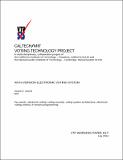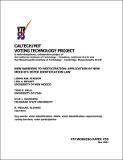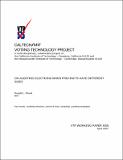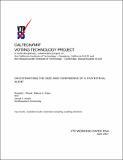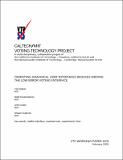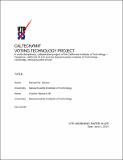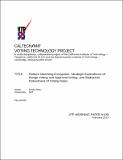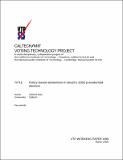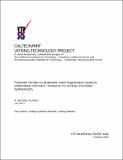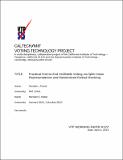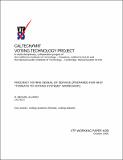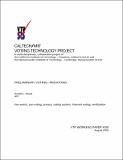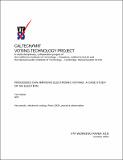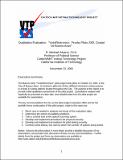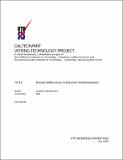Browsing Publications and Working Papers by Title
Now showing items 55-74 of 123
-
Mobilizing Pasadena Democrats: Measuring the Effects of Partisan Campaign Contacts
(Caltech/MIT Voting Technology Project, 2008-06-28)This paper examines the effect of an entire campaign using a randomized field experiment here the treatment consists of campaign decisions made by a campaign manager. In contrast to the majority of the field experiments ... -
A Modular Voting Architecture ("Frogs")
(Caltech/MIT Voting Technology Project, 2001-08-18)We present a “modular voting architecture” in which “vote generation” is performed separately from “vote casting.” -
An N-Version Electronic Voting System
(Caltech/MIT Voting Technology Project, 2004-05-20)The ballot battles of the 2000 US Presidential Election clearly indicate that existing voting technologies and processes are not sufficient to guarantee that every eligible voter is granted their right to vote and implicitly ... -
New Barriers to Participation: Application of New Mexico's Voter Identification Law
(Caltech/MIT Voting Technology Project, 2007-11)In democratic societies there is a tension between maximizing ballot access and minimizing voter fraud. Since the 2000 presidential election, this tension has been central to discussions about election reform, at the ... -
On Auditing Elections When Precincts Have Different Sizes
(Caltech/MIT Voting Technology Project, 2007-04-29)We address the problem of auditing an election when precincts may have different sizes, and suggest methods for picking a sample of precincts to audit that takes precinct size into account. one method yields optimal auditing ... -
On Estimating the Size and Confidence of a Statistical Audit
(Caltech/MIT Voting Technology Project, 2007-04-22)We consider the problem of statistical sampling for auditing elections, and we develop a remarkably simple and easily-calculated upper bound for the sample size necessary for determining with probability at least c whether ... -
Orienting Graphical User Interfaces Reduces Errors: The Low Error Voting Interface
(Caltech/MIT Voting Technology Project, 2005-02)This paper demonstrates opportunities for reducing errors with orienting graphical interfaces for voting. We have built many interfaces to explore opportunities for keeping voters aware of selections they have made and are ... -
Partisanship and Voter Confidence, 2000-2012
(Caltech/MIT Voting Technology Project, 2014-06-01)To what degree is voter confidence in election procedures driven by satisfaction with the outcome of an election, as opposed to trust in government or objective features of the polling place, such as voting technology? ... -
Pattern Matching Encryption, Strategic Equivalence of Range Voting and Approval Voting, and Statistical Robustness of Voting Rules
(Caltech/MIT Voting Technology Project, 2013-02)We present new results in the areas of cryptography and voting systems. 1. Pattern matching encryption: We present new, general definitions for queryable encryption schemes – encryption schemes that allow evaluation of ... -
Policy-based abstention in Brazil's 2002 presidential election
(Caltech/MIT Voting Technology Project, 2009-03)This paper implements a unified model of individual abstention and vote choice to analyze policy-based alienation and indifference in Brazil’s 2002 presidential election. The results indicate that both alienation and ... -
Poll Workers and Polling Places
(Caltech/MIT Voting Technology Project, 2011-04-16)In the year after the 2000 presidential election debacle in Florida, there was a sharp focus by many organizations, commissions, and interest groups to determine how to address the problems associated with ensuring that ... -
Potential Threats to Statewide Voter Registration Systems
(Caltech/MIT Voting Technology Project, 2005-10-06)The Help America Vote Act (HAVA), passed in 2002, requires that states implement "...a single, uniform, official, centralized, interactive computerized statewide voter registration list defined, maintained, and administered ... -
Practical End-to-End Verifiable Voting via Split-Value Representations and Randomized Partial Checking
(Caltech/MIT Voting Technology Project, 2014-04-03)We describe how to use Rabin's "split-value" representations, originally developed for use in secure auctions, to efficiently implement end-to-end verifiable voting. We propose a simple and very elegant combination of ... -
Practical Provably Correct Voter Privacy Protecting End-to-End Voting Employing Multiparty Computations and Split Value Representations of Votes
(Caltech/MIT Voting Technology Project, 2014-05-12)Continuing the work of Rabin and Rivest we present another simple and fast method for conducting end to end voting and allowing public verification of correctness of the announced vote tallying results. This method was ... -
Precinct Voting Denial of Service
(Caltech/MIT Voting Technology Project, 2005-10-05)This is a type of threat that has a long history in electoral politics, and can take many forms. The basic approach is that a perpetrator attacks precinct voting, regardless of voting system, on election day in an effort ... -
Preliminary Voting -- Prevoting
(Caltech/MIT Voting Technology Project, 2005-08-06)We introduce the notion of preliminary voting, or pre-voting, wherein a voter deposits—perhaps over the Internet—a preliminary vote or prevote with election authorities at some time before the close of elections. Prevotes ... -
Processes Can Improve Electronic Voting: A Case Study of An Election
(Caltech/MIT Voting Technology Project, 2004-09-07)Across the United States, I have personally watched hundreds of precincts vote since 2001. Most recently, I traveled to Reno/Sparks, Nevada to observe the rollout of the Sequoia Direct record electronic voting systems with ... -
Qualitative Evaluation: "VotoElectronico: Prueba Piloto 2005, Ciudad De Buenos Aires"
(Caltech/MIT Voting Technology Project, 2005-11-22)The Buenos Aires “VotoElectronico” pilot project took place on October 23, 2005, in the City of Buenos Aires. It involved a pilot test of four different electronic voting systems, in at least 43 voting stations located ... -
Racial Differences in Election Administration
(Caltech/MIT Voting Technology Project, 2009-07-25) -
Rational and Pluralistic Approaches to HAVA Implementation
(Caltech/MIT Voting Technology Project, 2005-07)The Help America Vote Act (HAVA) has created a new dynamic for the oversight and implementation of federal elections, requiring states to assume greater control of election processes vis-a-vis their local governments than ...


